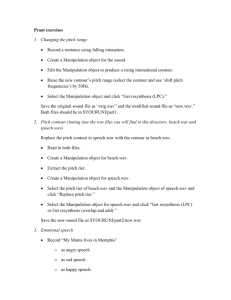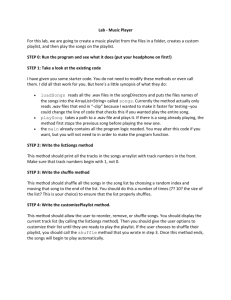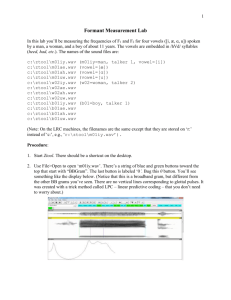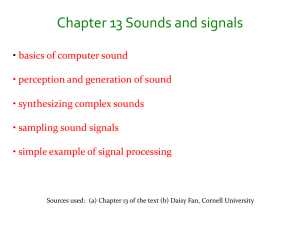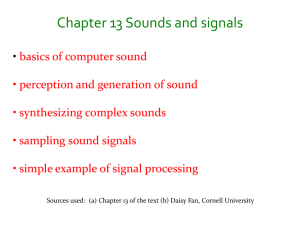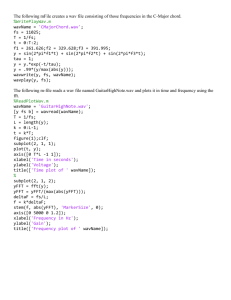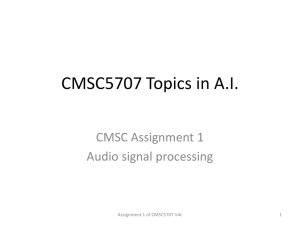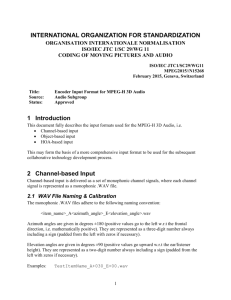Material-recorded-2012-Oct-Nov_lists003-to
advertisement
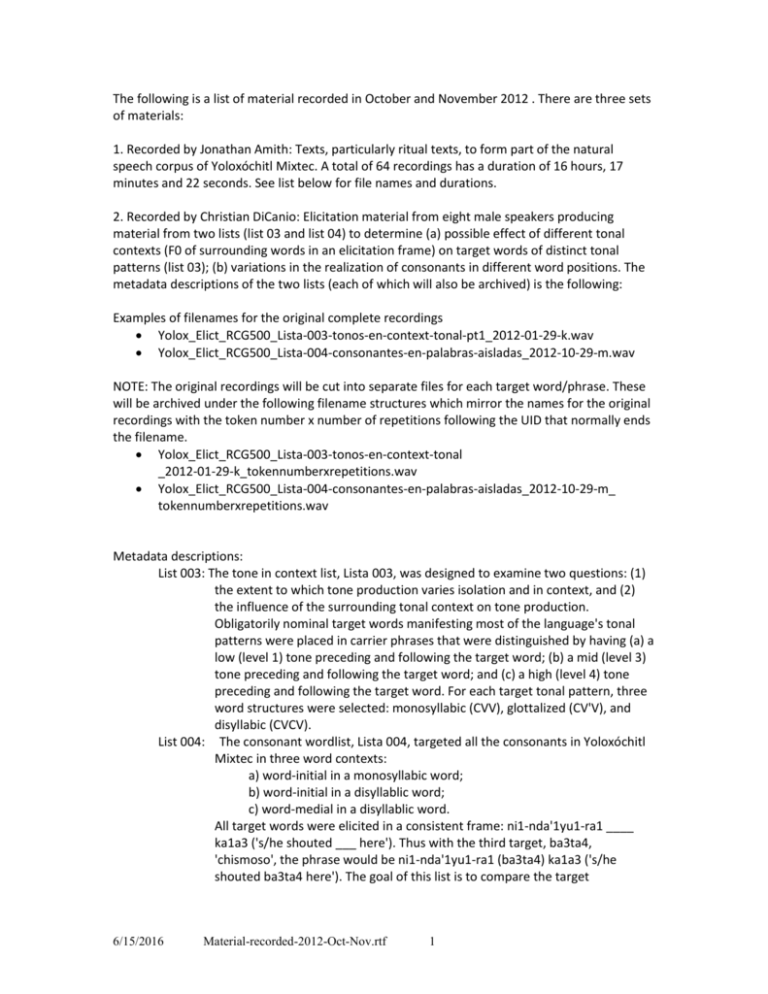
The following is a list of material recorded in October and November 2012 . There are three sets
of materials:
1. Recorded by Jonathan Amith: Texts, particularly ritual texts, to form part of the natural
speech corpus of Yoloxóchitl Mixtec. A total of 64 recordings has a duration of 16 hours, 17
minutes and 22 seconds. See list below for file names and durations.
2. Recorded by Christian DiCanio: Elicitation material from eight male speakers producing
material from two lists (list 03 and list 04) to determine (a) possible effect of different tonal
contexts (F0 of surrounding words in an elicitation frame) on target words of distinct tonal
patterns (list 03); (b) variations in the realization of consonants in different word positions. The
metadata descriptions of the two lists (each of which will also be archived) is the following:
Examples of filenames for the original complete recordings
Yolox_Elict_RCG500_Lista-003-tonos-en-context-tonal-pt1_2012-01-29-k.wav
Yolox_Elict_RCG500_Lista-004-consonantes-en-palabras-aisladas_2012-10-29-m.wav
NOTE: The original recordings will be cut into separate files for each target word/phrase. These
will be archived under the following filename structures which mirror the names for the original
recordings with the token number x number of repetitions following the UID that normally ends
the filename.
Yolox_Elict_RCG500_Lista-003-tonos-en-context-tonal
_2012-01-29-k_tokennumberxrepetitions.wav
Yolox_Elict_RCG500_Lista-004-consonantes-en-palabras-aisladas_2012-10-29-m_
tokennumberxrepetitions.wav
Metadata descriptions:
List 003: The tone in context list, Lista 003, was designed to examine two questions: (1)
the extent to which tone production varies isolation and in context, and (2)
the influence of the surrounding tonal context on tone production.
Obligatorily nominal target words manifesting most of the language's tonal
patterns were placed in carrier phrases that were distinguished by having (a) a
low (level 1) tone preceding and following the target word; (b) a mid (level 3)
tone preceding and following the target word; and (c) a high (level 4) tone
preceding and following the target word. For each target tonal pattern, three
word structures were selected: monosyllabic (CVV), glottalized (CV'V), and
disyllabic (CVCV).
List 004: The consonant wordlist, Lista 004, targeted all the consonants in Yoloxóchitl
Mixtec in three word contexts:
a) word-initial in a monosyllabic word;
b) word-initial in a disyllablic word;
c) word-medial in a disyllablic word.
All target words were elicited in a consistent frame: ni1-nda'1yu1-ra1 ____
ka1a3 ('s/he shouted ___ here'). Thus with the third target, ba3ta4,
'chismoso', the phrase would be ni1-nda'1yu1-ra1 (ba3ta4) ka1a3 ('s/he
shouted ba3ta4 here'). The goal of this list is to compare the target
6/15/2016
Material-recorded-2012-Oct-Nov.rtf
1
consonants in this data set with the same consonants as manifested in
running speech corpus data.
3. Recorded by Ryan Shosted: Elicitation material from eight male speakers producing material
from four lists (list 005, list 006, list 007, list 008) to study airflow dynamics of nasalization.
Simultaneous nasal and oral flow were collected using a Glottal Enterprises OroNasal airflow
mask fitted with Biopac TSD137 pneumotachometers attached via rubber cannulae to Biopac
TSD160 pressure transducers. Audio was sampled using an AKG-C520 head-mounted condenser
microphone. Signals were recorded using Biopac AcqKnowledge software in order to monitor
signals in real-time. Software limitations allowed for a maximum sampling rate of 2 kHz. Oral
flow, nasal flow, and audio were all sampled at 2 kHz. Oral and nasal pneumotachometers were
calibrated using a 600 ml calibration syringe. Subsequently the same four lists were (will be)
recorded using a Shure SM10a headworn dynamic microphone at 48KHz, 16 bit. Because of time
limitations, in the October and November 2012 sessions only one consultant has been recorded
for this acoustic data. The other seven will be recorded in March or April 2013.
The original recordings were in a proprietary format with extension .acq. All these files will
be converted to three .wav files. Note that in the original files each token is a separate file.
nasal airflow
oral airflow
acoustic signal
To avoid problems of duplication of UIDs, each filename will be given a unique UID that will be in
all filenames. The UIDs are a date format followed by a letter (e.g., 2012-10-19-a, etc.). Often
the UID is the date of the recording plus the letter, though sometimes it may be another "date".
To avoid problems all nasalization studies will have 2012-11-04-LETTER. The following are the
correspondences.
Nasalization study with mask
AGR524
CTB501
ECG503
EGS505
FNL520
MFG512
MMT517
RCG500
MSF515
List 05
2012-11-05-a
2012-11-05-b
2012-11-05-c
2012-11-05-d
2012-11-05-e
2012-11-05-f
2012-11-05-g
2012-11-05-h
2012-11-05-i
List 06
2012-11-06-a
2012-11-06-b
2012-11-06-c
2012-11-06-d
2012-11-06-e
2012-11-06-f
2012-11-06-g
2012-11-06-h
2012-11-06-i
List 07
2012-11-07-a
2012-11-07-b
2012-11-07-c
2012-11-07-d
2012-11-07-e
2012-11-07-f
2012-11-07-g
2012-11-07-h
2012-11-07-i
List 08
2012-11-08-a
2012-11-08-b
2012-11-08-c
2012-11-08-d
2012-11-08-e
2012-11-08-f
2012-11-08-g
2012-11-08-h
2012-11-08-i
Each speaker (with the exception of MSF515) completed 3 repetitions of Lists 5-8. MSF515
completed 1 repetition of Lists 5-8 plus an additional repetition of List 5. This speaker made a
great deal of errors so although archived, his recordings will not figure into further analysis. Each
pass through the list involved one utterance of the target phrase. There were 3 repetitions with
each speaker. The tokens will be given a final letter (after the token's Unique Identification
Number) that corresponds to the repetition: 1st=a, 2nd=b, 3rd=c. The token numbers will be
consecutive through the 4 lists (thus the first token of list 007 will be 146).
2
Material-recorded-2012-Oct-Nov.rtf
6/15/2016
The final filenames for the wave files will be standardized as follows:
Yolox_Elict_speakerUID _token[a,b or c]_List-05-nasal-airflow_2012-11-05-[letter]
Yolox_Elict_speakerUID _token[a,b or c]_List-05-oral-airflow_2012-11-05-[letter]
Yolox_Elict_speakerUID _token[a,b or c]_List-05-acoustic-2khz _2012-11-05-[letter]
Yolox_Elict_speakerUID_token[a,b or c] _List-06-nasal-airflow_2012-11-06-[letter]
Yolox_Elict_speakerUID _token[a,b or c]_List-06-oral-airflow_2012-11-06-[letter]
Yolox_Elict_speakerUID _token[a,b or c]_List-06-acoustic-2khz _2012-11-06-[letter]
Yolox_Elict_speakerUID_token[a,b or c] _List-07-nasal-airflow_2012-11-07-[letter]
Yolox_Elict_speakerUID _token[a,b or c]_List-07-oral-airflow_2012-11-07-[letter]
Yolox_Elict_speakerUID_token[a,b or c] _List-07-acoustic-2khz _2012-11-07-[letter]
Yolox_Elict_speakerUID _token[a,b or c]_List-08-nasal-airflow_2012-11-08-[letter]
Yolox_Elict_speakerUID _token[a,b or c]_List-08-oral-airflow_2012-11-08-[letter]
Yolox_Elict_speakerUID _token[a,b or c]_List-08-acoustic-2khz _2012-11-08-[letter]
For example, the first word on list 5 repeated in three sessions by Rey Castillo Garcia would be
Yolox_Elict_RCG500_001a _List-05-nasal-airflow_2012-11-05-h
Yolox_Elict_RCG500_001b _List-05-nasal-airflow_2012-11-05-h
Yolox_Elict_RCG500_001c _List-05-nasal-airflow_2012-11-05-h
Yolox_Elict_ RCG500_001a_List-05-oral-airflow_2012-11-05-h
Yolox_Elict_ RCG500_001b_List-05-oral-airflow_2012-11-05-h
Yolox_Elict_ RCG500_001c_List-05-oral-airflow_2012-11-05-h
Yolox_Elict_ RCG500_001a_List-05-acoustic-2khz _2012-11-05-h
Yolox_Elict_ RCG500_001b_List-05-acoustic-2khz _2012-11-05-h
Yolox_Elict_ RCG500_001c_List-05-acoustic-2khz _2012-11-05-h
The acoustic recordings will be given as follows. Note that the UID for nasal-airflow, oral-airflow,
acoustic are all the same for each speaker. This is because the three files are all derived from
one original. However, the separate acoustics file will have a separate UID
Separate acoustics of nasalization elicitation lists
AGR524
CTB501
ECG503
EGS505
FNL520
MFG512
MMT517
RCG500
MSF515
6/15/2016
List 05
2012-12-05-a
2012-12-05-b
2012-12-05-c
2012-12-05-d
2012-12-05-e
2012-12-05-f
2012-12-05-g
2012-12-05-h
2012-12-05-i
List 06
2012-12-06-a
2012-12-06-b
2012-12-06-c
2012-12-06-d
2012-12-06-e
2012-12-06-f
2012-12-06-g
2012-12-06-h
2012-12-06-i
Material-recorded-2012-Oct-Nov.rtf
List 07
2012-12-07-a
2012-12-07-b
2012-12-07-c
2012-12-07-d
2012-12-07-e
2012-12-07-f
2012-12-07-g
2012-12-07-h
2012-12-07-i
3
List 08
2012-12-08-a
2012-12-08-b
2012-12-08-c
2012-12-08-d
2012-12-08-e
2012-12-08-f
2012-12-08-g
2012-12-08-h
2012-12-08-i
Yolox_Elict_speakerUID _tokenxrep _List-05-separate-acoustics-48Khz _2012-12-05-h
For example, the first word on list 5 repeated 3 times by Rey Castillo García would be
Yolox_Elict_RCG500_001x3_List-05-separate-acoustics-48Khz _2012-12-05-h
The following are the metadata descriptions for each list:
List 05 (List-005-Mixtec-Nasalization-Study-List-2012-11): This is a list of 41
monomorphemic words of the form C1V1C2V2 . Tonal patterns are varied to
study possible effects of tone on nasalization. The values for C2 are: /s/, /x/,
/ch/, /t/, /k/ (/x/ represents a voiceless palato-alveolar fricative). The final
vowels are /u/, /i/, /a/ vs. /un/, /in/, /an/. There are no words with enclitics.
Tonal patterns are 1.1, 1.4, 13.2, 14.2, 14.3, 14.4, 3.2, 3.3., 3.4, 4.1, 4.2, 4.3,
4.4. Insofar as possible, oral/nasal (CVCV/CVCVn) pairs are matched for
identical or similar tonal patterns to avoid confounds between high tone
(possibly resulting from higher subglottal pressure) and observations of higher
airflow. Data were collected in the carrier phrase "ni1-nda'1yu1-ra1 ___
ta4ta2", "I yelled ___ father" except for a few exceptions where the test
material had to follow another word in order to make sense to the speaker.
The list is meant to explore the following research questions:
In disyllabic monomorphemic words, is nasalization present on V1 if V2
is underlyingly nasal (regressive nasalization)?
Is the presence/degree of nasalization in V1 related to the kind of
obstruent C2 (anterior vs. posterior fricative / fricative vs. stop)?
What are the differences in degree of nasalization between V1 and
V2(nasal) in a V2(nasal)–final word or between V2(oral) and V2(nasal)?
What is the effect, if any, of tonal contour on nasalization?
List 06 (List-006-Mixtec-Nasalization-Study-List-2012-11): This is a list of 104
monomorphemic words of the form C1V1V1 and C1V1Vn1 and C1V'1V1 and
C1V'1Vn1 (i.e., CVV words in which the vowels are +nasal /-nasal or
+laryngealized/-laryngealized. The vowels are /uu/, /ii/, /aa/ vs. /uun/, /iin/,
/aan/ and /u'u/, /i'i/, /a'a/ vs. /u'un/, /i'in/, /a'an/. Tonal patterns are varied
to study possible effects of tone on nasalization. Tonal patterns on the target
word are: 1.1, 1.3, 1.4, 3.2, 3.3, 3.4, 4.2, 4.4 without enclitics, and 1.1=1,
1.1=4, 1.4=3, 1.4=4, 3.3=3, 3.3=4, 3.4=4, 4.2=2, 4.2=4, 4.4=3, and 4.4=4, with
enclitics. Data were collected in the carrier phrase "ni1-nda'1yu1-ra1 ___
ta4ta2", "I yelled ___ father" except for a few exceptions where the test
material had to follow another word in order to make sense to the speaker.
The target words are elicited with oral and nasal enclitics:
=on4, =un4
2sg
=an4, =en4
3sgFem
=o4, =e4
1plInclusive
=aT, =eT
inanimate (T indicates variable tone depending on final
tone of word and phrase final or medial)
There is one example of a target word with two enclitics =on4=a3 [=an43].
4
Material-recorded-2012-Oct-Nov.rtf
6/15/2016
The list is meant to explore the following research questions:
When nasal enclitics are added to dimoraic monomorphemic words of
the form CVV (with oral vowels), what is the degree and time course
of nasalization prompted by the enclitic on preceding segmental
material?
Does laryngealization/glottalization affect the regressive spread of
nasalization.
When oral enclitics are added to dimoraic monomorphemic words of
the form CVVn (with nasal vowels), what is the degree and time
course of decreasing nasalization of the root vowels prompted by the
oral enclitic?
Does laryngealization/glottalization affect the spread
ofnasalization/denasalization on the root vowels?
What is the relationship of tonal contours to nasalization patterns?
List 07 (List-007-Mixtec-Nasalization-Study_2012-11.docx): This is a list of 139
monomorphemic words of the following forms: NVV, NV'V, ndVV, ndV'V,
CVNV, NVNV, CVndV, and CV'ndV. Nasals are /m/, /n/, /ñ/. Final vowels are
/u/, /i/, /a/. Note that no final vowel is written Vn though those following a
nasal consonant (N, not /nd/) are nasal/nasalized. Tonal patterns are varied to
study possible effects of tone on nasalization. Tonal patterns on the target
word are: 1.1, 1.3, 1.4, 3.2, 3.3, 3.4, 4.1, 4.2, 4.3, 4.4 without enclitics and
1.1=1, 1.1=4, 1.1=4=3, 1.3=3, 1.3=4, 1.4=3, 1.4=4, 3.2=2, 3.2=4, 3.3=3, 3.3=4,
4.1=1, 4.1=4, 4.2=2, 4.2=4, 4.3=4, 4.4=3, and 4.4=4. Data were collected in the
carrier phrase "ni1-nda'1yu1-ra1 ___ ta4ta2", "I yelled ___ father" except for a
few exceptions where the test material had to follow another word in order to
make sense to the speaker. The target words are elicited with oral and nasal
enclitics. Some items have two enclitics.
=on4, =un4
2sg
=an4, =en4
3sgFem
=o4, =e4
1plInclusive
=aT, =eT
inanimate (T indicates variable tone depending on final
tone of word and phrase final or medial)
The list is meant to explore the following research questions:
Are vowels before /nd/ nasalized to any extent? If so, does glottalization
affect the degree of nasalization?
How is nasalization realized in words of the form NVV and NV'V?
Does glottalization in NV'V affect the nature of nasalization (e.g., as
compared to NVV)? Is there any effect in CVndV vs. CV'ndV?
How is nasalization in NVV and NV'V words affected by enclitics with (a)
oral vowels; (b) nasal vowels?
Does regressive nasalization occur in CVNV words? In CVndV words?
When nasal enclitics are added to CVNV, NVNV, CVndV and CV'ndV
6/15/2016
Material-recorded-2012-Oct-Nov.rtf
5
words, how is nasalization of the preceding vowels affected?
When oral enclitics are added to CVNV and NVNV words (and perhaps
to CVndV and CV'ndV words), how is nasalization of the preceding
vowels affected?
Does glottalization affect the nature of regressive nasalization when a
nasal enclitics is added to a NV'V, ndV'V or CV'ndV word?
List 08 (List-008_Mixtec-Nasalization-Study_2012-11.docx): This is a list of 60
monomorphemic trimoraic words of the following forms: CVCVV and CVCVVn
without and with enclitics (sometimes two enclitics). Final vowel sequences
are /uu/, /ii/, /aa/ and /uun/, /iin/, /aan/. No words have a glottalized final
long vowel (e.g., CVCV'V). C2 ranges between /x/ /kw/ /s/ /m/ /kw/ /ñ/ /k/
and /nd/. In no cases was C2 preceded by a glottal stop/laryngealized vowel.
Tonal patterns are varied to study possible effects of tone on nasalization.
Tonal patterns on the target word are: 1.1.1, 1.1.4, 3.1.1, 3.2.2, 3.3.3, 3.3.4,
4.3.3, 4.3.4 without enclitics and 1.1.1=1, 1.1.1=4, 1.1.4=3, 1.1.4=4, 3.2.2=2,
3.2.2=4, 3.2.2=4=3, 3.3.3=4, 3.3.3=4.3, 3.3.4=3, 3.3.4=4, 3.3.4=4=3, 4.3.3=4,
4.3.4=3, 4.3.4=4 with enclitics. Note that one word with 3.1.1 (ba1xa1a1
'arrive') was not elicited with enclitics. Data were collected in the carrier
phrase "ni1-nda'1yu1-ra1 ___ ta4ta2", "I yelled ___ father" except for a few
exceptions where the test material had to follow another word in order to
make sense to the speaker. The target words are elicited with oral and nasal
enclitics. Some items have two enclitics.
=on4, =un4
2sg
=an4, =en4
3sgFem
=o4, =e4
1plInclusive
=aT, =eT
inanimate (T indicates variable tone depending on final
tone of word and phrase final or medial)
=on4=a3
2sg+inanimate
=un4=a3
2sg+inanimate
The list is meant to explore the following research questions:
When nasal enclitics are added to trimoraic monomorphemic words
with oral and with nasal final long vowels, what is the degree and time
course of oral and nasal air flow on preceding segmental material?
When oral enclitics are added to trimoraic monomorphemic words with
oral and with nasal final long vowels, what is the degree and time
course of oral and nasal airflow on preceding segmental material?
Does the presence of a nasal C2 consonant condition an either
progressive or regressive nasalization. What is the degree and time
course of nasalization over the following long vowel when a clitic is not
present. How is this affected with the presence of an (a) oral enclitic; (b)
nasal enclitic?
Does vowel length of the final vowel affect the degree and time course
of nasalization (as compared to target words of the form CVCV?
What are the nasal properties of the portmanteau enclitic sequences
6
Material-recorded-2012-Oct-Nov.rtf
6/15/2016
=on4=a3 and =un4=a3 (realized as [an43]). Apart from nasalization,
what is the tone target of 43 as compared to 4 and 3.
Non-elicitation recordings
Yolox_Agric_MSF515_El-cultivo-de-maiz_2012-11-02-b.wav
Yolox_Botan_CTB501-EGS505_I3ta2-kwe1e1-nu14u3-Asteraceae_2012-10-27-g.wav
Yolox_Botan_CTB501-MFG512_I3ta2-tio14ko3-Asteraceae_2012-10-27-d.wav
Yolox_Botan_CTB501-MFG512_I3ta2-yu1ku1-li4ma4-Asteraceae_2012-10-27-f.wav
Yolox_Botan_CTB501-MFG512_Yu1ku1-tio1o3t-si1ba1_Familia-pendiente_2012-10-27-c.wav
Yolox_Comid_CTB501-MFG512_Preparacion-de-tamales-tipos-de-hojas_2012-10-27-e.wav
Yolox_Creer_AGR524-RCG500_Los-mal-agueros_2012-10-30-b.wav
Yolox_Creer_FNL520-ECG503_Los-mal-agueros-animales-y-otros_1011_2012-11-01-g.wav
Yolox_Creer_MSF515_El-senyor-del-fuego-y-el-senyor-de-la-lluvia_2012-10-28-i.wav
Yolox_Creer_MSF515_Los-maxikwilu_2012-11-01-a.wav
Yolox_Creer_MSF515_Los-xaki-yuku-y-otros-demonios_2012-10-28-b.wav
Yolox_Creer_MSF515_Los_kwa14ku3-y-los-remedios_2012-10-28-h.wav
Yolox_Cuent_CTB501-FNL520_yo3ko2-nyu4nyu4-y-Chilpancingo_2012-11-03-d.wav
Yolox_Cuent_MFG512_El-cantor-y-las-tres-palomas_2012-11-01-c.wav
Yolox_Cuent_MSF515_Comisario-y-ancianos-nombran-los-dias-sol-luna_2012-11-01-b.wav
Yolox_Cuent_MSG516_Los-dos-ninyos-se-transformaron-en-sol-y-luna_2012-10-29-c.wav
Yolox_Cuent_VRR504_El-muchacho-que-pidio-consejo-a-un-anciano_2012-10-29-d.wav
Yolox_Medic_AGR524_Consulta-de-medir-el-brazo_2012-10-28-g.wav
Yolox_Medic_MSG516-RCG500_Consulta-de-medir-el-brazo_2012-10-29-f.wav
Yolox_Narra_MFG512_Testimonio-de-experiencia-mayordomias-y-cargos_2012-10-29-h.wav
Yolox_Narra_MFG512_Testimonio-sobre-asesinato-de-rico-de-Yolox_2012-11-01-d.wav
Yolox_Narra_MSF515_Testimonio-Como-fue-mordido-por-una-vibora_2012-11-02-a.wav
Yolox_Narra_SRG523_Tenencia-de-tierras-comunales-y-linderos-Yolo_2012-10-27-a.wav
Yolox_Ritua_AGR524-CTB501_Pedimiento-de-novia-recreacion-del-proceso-pt-1_2012-10-27-b.wav
Yolox_Ritua_AGR524-CTB501_Pedimiento-de-novia-recreacion-del-proceso-pt-2_2012-10-28-d.wav
Yolox_Ritua_AGR524_Nda3na1ma3-cambio-de-anyo_2012-10-28-f.wav
Yolox_Ritua_AGR524_Rezo-para-curar-uno-afectado-de-kwa14ku2_2012-10-30-a.wav
Yolox_Ritua_AGR524_Rito-de-pedir-la-lluvia_2012-10-28-e.wav
Yolox_Ritua_MSF515_Nda3na1ma3-cambio-de-anyo_2012-10-28-c.wav
Yolox_Ritua_MSF515_Rito-de-pedir-la-lluvia_2012-10-28-a.wav
Yolox_Ritua_MSG516-VRR504_Contentar-a-los-padres-de-una-novia-fugada_2012-10-29-g.wav
Yolox_Ritua_MSG516_Nda3na3ma3-cambio-de-anyo_2012-10-29-e.wav
Yolox_Ritua_MSG516_Rezo-para-la-lluvia_2012-10-29-b.wav
Yolox_Ritua_MSG516_Rezo-para-las-autoridades-antes-de-pedir-lluvia_2012-10-29-a.wav
Yolox_Zoolo_CTB501-ECG503_El-ti1ko3so3-ni4nyu2_2012-11-01-e.wav
Yolox_Zoolo_CTB501-ECG503_Ti1ka4an4_Whip-scorpion-and-solifugae_2012-11-01-f.wav
Yolox_Zoolo_CTB501-FNL520_tio1ko4-be3e3-Formicidae_2012-11-03-a.wav
Yolox_Zoolo_CTB501-FNL520_tio1ko4-i1in1-Formicidae_2012-11-03-b.wav
Yolox_Zoolo_CTB501-FNL520_tio1ko4-i3ya4-Formicidae_2012-11-03-c.wav
Yolox_Zoolo_CTB501-FNL520_tio1ko4-ka4ya24-Formicidae_2012-11-03-e.wav
Yolox_Zoolo_CTB501-FNL520_tio1ko4-kwa4a-Formicidae_2012-11-03-f.wav
6/15/2016
Material-recorded-2012-Oct-Nov.rtf
7
009:56
005:10
016:34
008:47
004:10
007:03
028:05
027:00
033:19
009:19
025:10
026:02
005:11
031:26
015:28
029:33
014:38
007:15
007:38
033:03
011:02
013:18
030:17
056:34
064:13
012:03
019:22
039:17
018:13
032:59
098:24
025:42
040:35
040:21
002:50
002:34
005:54
005:58
008:51
008:03
006:45
Yolox_Zoolo_FNL520-CTB501_tio1ko4-kwa4a2-ji1ni4-Formicidae_2012-11-03-g.wav
Yolox_Zoolo_FNL520-CTB501_tio1ko4-nda1ba32-Formicidae_2012-11-03-h.wav
Yolox_Zoolo_FNL520-CTB501_tio1ko4-nyu4nyu4-Formicidae_2012-11-03-i.wav
Yolox_Zoolo_FNL520-CTB501_tio1ko4-pan42-Formicidae_2012-11-03-j.wav
Yolox_Zoolo_FNL520-CTB501_tio1ko4-si14bi3-Formicidae_2012-11-03-k.wav
Yolox_Zoolo_FNL520-CTB501_tio1ko4-su4ma3-Formicidae_2012-11-03-l.wav
Yolox_Zoolo_FNL520-CTB501_tio1ko4-tia14ta4-Formicidae_2012-11-03-m.wav
Yolox_Zoolo_FNL520-CTB501_tio1ko4-tiu13ba2-kwa4a2-Formicidae_2012-11-03-n.wav
Yolox_Zoolo_FNL520-CTB501_tio1ko4-tu4mi4-Formicidae_2012-11-03-o.wav
Yolox_Zoolo_FNL520-CTB501_tio1ko4-xa4an2-Formicidae_2012-11-03-p.wav
Yolox_Zoolo_FNL520-CTB501_tio1ko4-xa4yu2-Formicidae_2012-11-03-q.wav
Yolox_Zoolo_FNL520-CTB501_ti1kwe4ku3_2012-11-03-r.wav
Yolox_Zoolo_FNL520-ECG503_Avispa-named-yo3ko2-lu3tu3_2012-11-01-j.wav
Yolox_Zoolo_FNL520-ECG503_Avispa-named-yo3ko2-ndia14na3_2012-11-01-p.wav
Yolox_Zoolo_FNL520-ECG503_Avispa-named-yo3ko2-ndi1xan4_2012-11-01-l.wav
Yolox_Zoolo_FNL520-ECG503_Avispa-named-yo3ko2-ndi13xi2_2012-11-01-o.wav
Yolox_Zoolo_FNL520-ECG503_Avispa-named-yo3ko2-ndo1o4_2012-11-01-n.wav
Yolox_Zoolo_FNL520-ECG503_Avispa-named-yo3ko2-ndu1xa4a2_2012-11-01-i.wav
Yolox_Zoolo_FNL520-ECG503_Avispa-named-yo3ko2-nyu4nyu4_2012-11-01-k.wav
Yolox_Zoolo_FNL520-ECG503_Avispa-named-yo3ko2-tejon_2012-11-01-r.wav
Yolox_Zoolo_FNL520-ECG503_Avispa-named-yo3ko2-ya4a1_2012-11-01-m.wav
Yolox_Zoolo_FNL520-ECG503_Avispa-named-yo3ko2-yu14ma1_2012-11-01-q.wav
Yolox_Zoolo_FNL520-ECG503_Avispas-comestibles-y-no-comestibles_2012-11-01-h.wav
Total
006:27
005:33
004:16
004:07
006:05
003:23
004:39
005:34
002:00
003:40
003:40
009:15
001:19
003:57
001:32
001:48
001:10
001:02
001:13
002:05
002:19
000:56
003:20
16:07:22
Elicitation recordings by Christian DiCanio
Yolox_Elict_CTB501_List-003-tonos-en-contexto-tonal-pt1_2012-10-28-l.wav
Yolox_Elict_CTB501_List-003-tonos-en-contexto-tonal-pt2_2012-10-29-i.wav
Yolox_Elict_CTB501_List-004-consonantes-en-palabras-aisladas_2012-10-29-j.wav
Yolox_Elict_ECG503_List-003-tonos-en-context-tonal-pt1_2012-10-31-a.wav
Yolox_Elict_ECG503_List-003-tonos-en-context-tonal-pt2_2012-10-31-b.wav
Yolox_Elict_ECG503_List-004-consonantes-en-palabras-aisladas_2012-10-31-c.wav
Yolox_Elict_EGS505_List-003-tonos-en-context-tonal-pt1_2012-10-30-c.wav
Yolox_Elict_EGS505_List-003-tonos-en-context-tonal-pt2_2012-10-30-d.wav
Yolox_Elict_EGS505_List-004-consonantes-en-palabras-aisladas_2012-10-30-e.wav
Yolox_Elict_FNL520_List-003-tonos-en-context-tonal_2012-11-01-v.wav
Yolox_Elict_FNL520_List-004-consonantes-en-palabras-aisladas_2012-11-01-w.wav
Yolox_Elict_MFG512_List-003-tonos-en-context-tonal-pt1_2012-01-29-n.wav
Yolox_Elict_MFG512_List-003-tonos-en-context-tonal-pt2_2012-01-29-o.wav
Yolox_Elict_MFG512_List-004-consonantes-en-palabras-aisladas_2012-10-29-p.wav
Yolox_Elict_MSF515_List-003-tonos-en-context-tonal-pt1_2012-11-01-s.wav
Yolox_Elict_MSF515_List-003-tonos-en-context-tonal-pt2_2012-11-01-t.wav
Yolox_Elict_MSF515_List-004-consonantes-en-palabras-aisladas_2012-11-01-u.wav
Yolox_Elict_RCG500_List-003-tonos-en-context-tonal-pt1_2012-01-29-k.wav
Yolox_Elict_RCG500_List-003-tonos-en-context-tonal-pt2_2012-01-29-l.wav
8
Material-recorded-2012-Oct-Nov.rtf
6/15/2016
043:07
019:14
013:07
029:08
023:13
013:36
045:09
018:56
016:39
037:30
010:09
028:55
025:57
015:17
040:00
022:23
018:07
028:29
027:34
Yolox_Elict_RCG500_List-004-consonantes-en-palabras-aisladas_2012-10-29-m.wav
Yolox_Elict_VRR504_List-003-tonos-en-contexto-tonal_2012-10-28-j.wav
Yolox_Elict_VRR504_List-004-consonantes-en-palabras-aisladas_2012-10-28-k.wav
Total
6/15/2016
Material-recorded-2012-Oct-Nov.rtf
9
014:27
058:47
018:40
9:28:24


